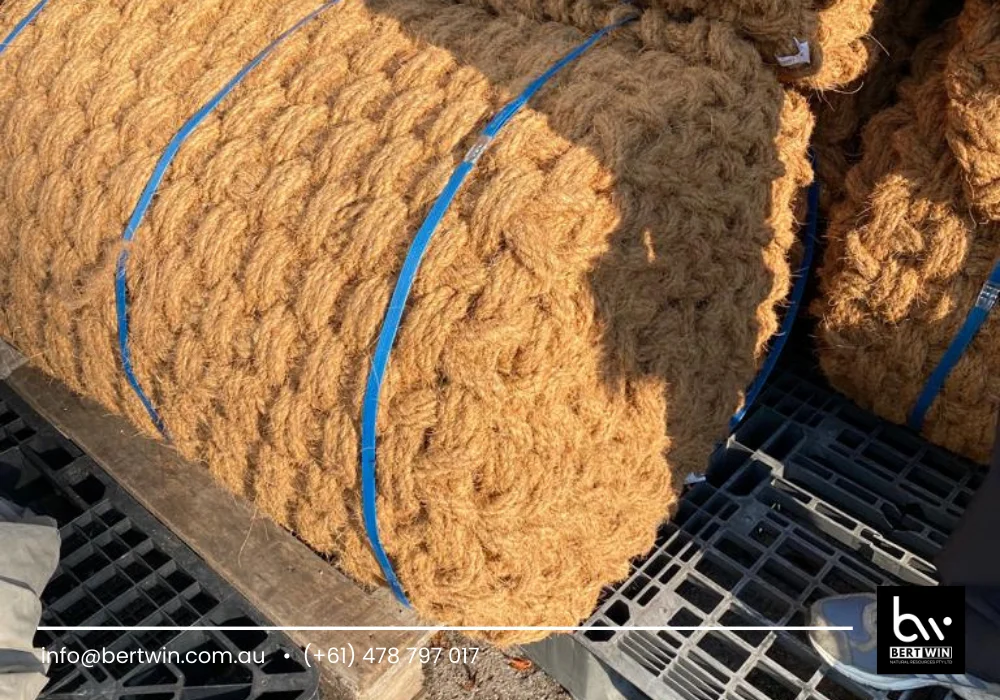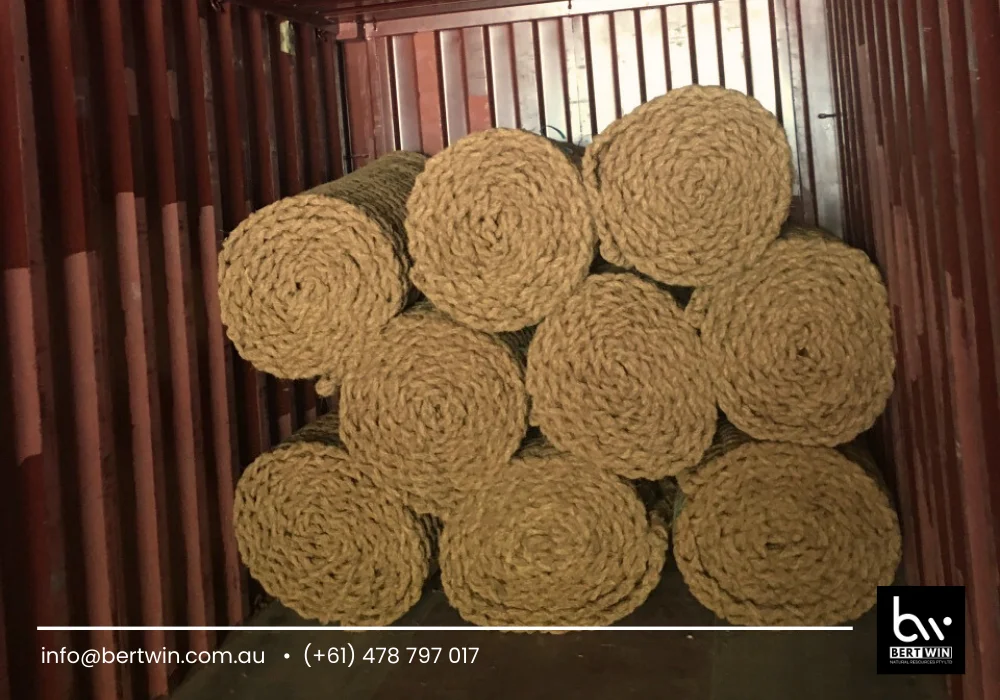
Did you know that soil erosion affects over 30% of the world’s land? Coir mat erosion control installation, a natural coconut fibre product, offers an effective solution to combat this pressing issue. These eco-friendly mats stabilize soil and promote vegetation growth, making them ideal for gardens, slopes, and construction sites. By choosing coir mats, you contribute to a sustainable environment while enhancing your landscape. Discover how this powerful coir net can protect your land from erosion and improve soil health today.
Understanding Coir Mats
Types of Coir Mats
Coir mats come in various types. They include coir geotextiles, coir rolls, and coir logs. Each type serves specific needs in erosion control. Coir geotextiles are flat mats made from woven coconut fibres. They provide a stable surface for vegetation growth. Coir rolls are cylindrical structures filled with coir fibre. They help stabilise slopes and prevent soil erosion. Coir logs, a natural coconut fibre product, are long cylinders used to create barriers against water flow and soil erosion.
Features and Benefits
Coir mats offer several key features. They are biodegradable, making them environmentally friendly. The natural fibres decompose over time, enriching the soil. These mats also promote plant growth by retaining moisture. Their fibrous structure helps trap sediment and reduce runoff. This leads to improved soil stability and health. Coir mats are lightweight, making them easy to install.
Applications in Erosion Control
Coir mats find use in various erosion control projects. They are effective on riverbanks, slopes, and construction sites. Engineers often recommend them for stabilising disturbed land areas. These mats help restore habitats by encouraging vegetation growth. They also protect against heavy rainfall and flooding.
Preparing for Installation
Site Assessment Steps
First, assess the area where coir mats will be installed. Look for signs of erosion or water flow patterns. Identify any vegetation that may need protection during installation. Measure the site to determine how many mats are required. Consider soil type and slope as these factors affect mat performance.
Next, check for drainage issues. Poor drainage can undermine the effectiveness of coir mats. Ensure that the site is accessible for equipment and materials. Mark out the installation area clearly to avoid confusion during the process.
Tools and Materials Needed
Gather essential tools before starting the installation. You will need shovels, rakes, and gloves for handling materials. A wheelbarrow will help transport coir mats to the site efficiently.
Materials include coir mats, biodegradable stakes, and biodegradable twine. These items secure the mats in place and promote stability. You may also require a compactor to ensure proper ground contact.
Safety Considerations
Safety is crucial during installation. Wear appropriate protective gear such as gloves and sturdy footwear. Be aware of your surroundings to avoid accidents with tools or equipment.
Check weather conditions before beginning work. Rain or strong winds can make installation hazardous. Always have a first aid kit on hand for emergencies.

Installation Process Guide
Preparing the Ground
Ground preparation is crucial before installing coir mats. Start by clearing the area of debris, rocks, and vegetation. This ensures a flat surface for proper mat placement. Next, assess the soil quality. If the soil is too loose, compact it to create stability.
Check for drainage issues as well. Proper drainage helps prevent water from pooling under the mats. If necessary, create small trenches to direct water away from the installation site.
Laying the Coir Mats
Laying coir mats requires careful attention. Begin at the lowest point of the slope to allow water to flow naturally over them. Unroll the mats across the prepared ground, ensuring they overlap slightly. This overlap prevents gaps that could lead to erosion.
Cut the mats as needed to fit around obstacles like trees or rocks. Ensure each piece lies flat against the ground.
Securing and Anchoring Techniques
Securing coir mats is essential for their effectiveness. Use stakes or pegs made of biodegradable materials to anchor them firmly in place. Drive these stakes into the ground at regular intervals along the edges and seams of the mats.
For added stability, consider using natural fibres or twine to tie down prominent areas. This method keeps mats secure during heavy rain or wind.
Post-Installation Checks
After installation, conduct thorough checks on your work. Inspect for any loose areas or gaps in the mats. Ensure all edges are well anchored and secure. Water drainage should function correctly without pooling.
Regular maintenance will extend the life of your coir mats and enhance their effectiveness in controlling erosion.
Enhancing Vegetation Growth
Selecting Suitable Plants
Choosing the right plants is crucial for effective erosion control. Native species are often the best choice. They adapt well to local conditions and support local wildlife. Consider plants with deep roots. These roots help stabilise the soil and improve water retention. Grasses, shrubs, and ground covers can all play a role.
Research local vegetation treatments to identify suitable options for your area. For example, planting native wildflowers can enhance biodiversity.
Maintenance Tips for Vegetation
Regular maintenance ensures healthy growth of vegetation cover. Water newly planted vegetation regularly, especially during dry spells. Mulching around plants can help retain moisture and suppress weeds.
Fertilise the plants as needed to promote strong growth. Remove any invasive species that compete with your chosen plants. This action allows natural vegetation to thrive without interference.
Monitoring Growth Progress
Monitoring the growth of your vegetation is essential. Check the health of the plants periodically. Look for signs of stress or disease, such as wilting or discolouration.
Document changes in plant cover over time. This record helps assess the effectiveness of your erosion control efforts. Use this information to adjust your care routine if necessary.

Summary
Coir mats offer an effective solution for erosion control, combining environmental benefits with ease of installation. You’ve learned how to prepare for and install these mats, as well as how they enhance vegetation growth. This knowledge empowers you to tackle erosion issues confidently.
Frequently Asked Questions
What are coir mats used for?
Coir mats are primarily used for erosion control. They stabilise soil, reduce runoff, and promote vegetation growth in areas prone to erosion.
How do I prepare for coir mat erosion control installation?
Prepare the site by clearing debris, removing weeds, and ensuring proper drainage. Soil should be level and compacted for optimal mat performance.
What is the installation process for coir mats?
Lay the coir mat flat on the prepared soil. Secure it with stakes or pegs, overlapping edges where necessary. Ensure good contact with the soil for maximum effectiveness.
Can coir mats enhance plant growth?
Yes, coir mats provide moisture retention and nutrients, creating an ideal environment for plant roots to establish and thrive.
How long do coir mats last?
Coir mats typically last between 2 to 5 years, depending on environmental conditions and maintenance practices. They biodegrade gradually, enriching the soil.
Are coir mats eco-friendly?
Absolutely! Coir mats are made from natural coconut fibres, making them biodegradable and sustainable. They support biodiversity while controlling erosion.
Where can I buy coir mats?
Coir mats can be purchased at garden centres, landscaping suppliers, or online retailers that specialise in gardening and erosion control products.
In conclusion, if you are eager to delve deeper into the details of coir products, feel free to explore our website at www.bertwin.com.au. Additionally, for direct and instant connection with our team, you can reach us through the following WhatsApp link here. We look forward to providing you with the information and assistance you need.
